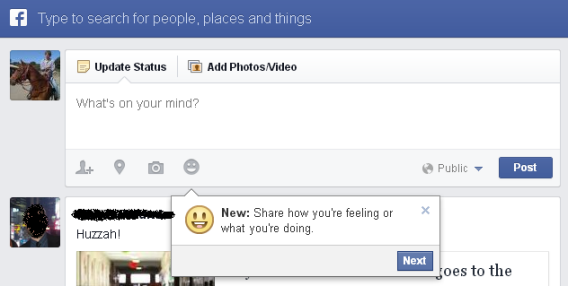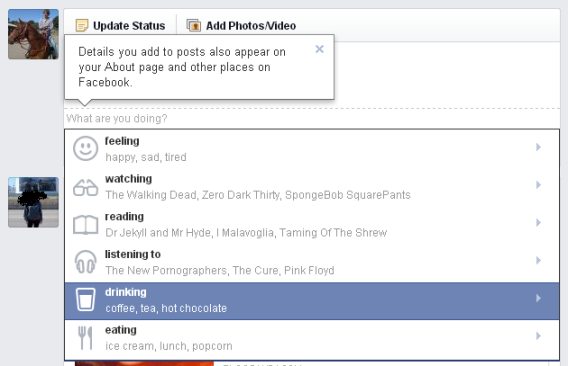Facebook is rolling out a new feature that looks like a whimsical blast of 1990s nostalgia. Starting with a limited number of U.S. users, the site is encouraging people to share how they’re feeling or what they’re doing by selecting from a drop-down menu of emoji and other icons. The initial prompt looks like this:

Screenshot / Facebook
The image at the top of this post shows the drop-down menu, complete with helpful suggestions for what specifically you might be feeling, watching, or drinking at the moment. And here’s the result:

Screenshot / Facebook
But you’re by no means limited to the vague and innocuous options Facebook suggests for you. When I start to type in the name of my favorite bourbon, Facebook is savvy enough to guess the brand I’m referring to and propose that as the top option in the drop-down menu. Now my status update links directly to the Facebook page for Pappy Van Winkle.

Screenshot / Facebook
As I said, the emoticons at first glance look like a frivolous throwback to the era of AIM, ICQ, and MySpace. But by now it should be clear that there’s more to them than meets the eye. As Josh Constine recognized when Facebook first tested the feature in January: “By selecting your current activity instead of merely writing it out, you structure data for Facebook.” He explained:
If you choose a particular pre-formatted emotion, piece of media, or food, Facebook could potentially use that behavior to pinpoint you with ads. If you listen to a Daft Punk song, it could target you with ads for their new album or [a] nearby concert. Coffee shops might be able to pay to reach coffee drinkers, and Netflix would probably love to target sad users who could be primed to stay home and watch some videos. Going further, Facebook could even sell “Sponsored Activities,” where advertisers could pay to have themselves suggested as what someone was up to in the category selector.
In theory, Facebook could try to derive the same information from your plain-English status updates by running them through natural-language processing algorithms. But turning informal, colloquial language into usable data is really hard. Even the smartest computers today are terrible at detecting irony, interpreting slang, or drawing inferences about people’s mental states based on their words. Google has some of its best minds working on that problem, and Facebook is clearly working on it too. But emoticons, along with hashtags, photo tags, “about” pages, and even the ubiquitous “like” button, appear to be part of a grand Facebook strategy to get its users to do a lot of the hard work themselves.
Of course, that’s not how Facebook is framing the feature. When I emailed the company for comment, a spokesman replied:
It is a new, more visual way for people to share how they’re feeling and what they’re doing in a status update. Now, you can easily add your current mood, what you’re listening to, reading, watching, eating, or drinking to your status update right from the new smiley face icon in the composer.
He added that the information contained in the emoticons is “not searchable in Graph Search at this time.” And Facebook told Constine in January that it wasn’t yet feeding the data into its ad engine. But it’s a safe bet that it will, provided the feature catches on. And then you’ll have what amounts to an extra privacy decision with each status update: Use the emoticons and gift-wrap your message for the data-miners, or stick to plain English and limit your audience to humans.
